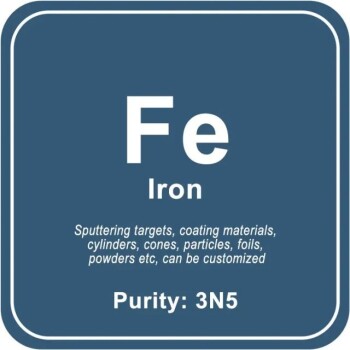Elemental analysis is a critical technique in various scientific fields, including chemistry, materials science, and environmental testing.
It involves identifying and quantifying the elemental composition of a sample.
Different analytical instruments utilize various physical and chemical principles to perform this analysis.
Here, we will explore the key methods and instruments used in elemental analysis, their principles, and their applications.
5 Key Methods Explained: How Elemental Analysis is Performed

1. Common Elemental Analysis Instruments and Methods
a. Ultraviolet/Visible Spectrophotometer (UV)
- Principle: Utilizes Beer's law (A=ξbC) where A is absorbance, ξ is the molar absorption coefficient, b is the sample thickness, and C is the sample concentration.
- Features: High sensitivity, good selectivity, high accuracy, wide applicable concentration range, low analysis cost, simple operation, and fast.
b. Atomic Absorption Spectrophotometer (AAS)
- Principle: Based on the phenomenon that gaseous atoms can absorb light radiation of a certain wavelength, causing outer electrons to transition from the ground state to the excited state.
- Features: High sensitivity, good selectivity, simple and fast operation, good measurement precision, and can measure more than 70 elements.
c. Atomic Fluorescence Spectrophotometer (AFS)
- Principle: Uses the intensity of fluorescence emitted by atoms under the stimulation of radiation energy for quantitative analysis.
- Features: Low detection limit, high sensitivity, less interference, simple instrument structure, and low price.
d. Atomic Emission Spectrophotometer (AES)
- Principle: Electrons outside the nucleus of an atom move from the ground state to the excited state and then return, releasing energy in the form of light, resulting in an emission spectrum.
- Features: High temperature, good stability, good detection limit, small matrix effect, and wide linear range.
e. Inductively Coupled Plasma Mass Spectrometry (ICP-MS)
- Principle: Ionizes components in the sample to generate ions with different charge-to-mass ratios, which are then analyzed by a mass analyzer.
- Features: Wide mass measurement range, high resolution, and high absolute sensitivity.
f. X-ray Fluorescence Spectrophotometer (XRF)
- Principle: Excited samples emit secondary X-rays with specific energy characteristics or wavelength characteristics, which are measured to determine element types and contents.
- Features: Fast, non-destructive, and wide content range.
2. Micro-area Composition Analysis
a. Energy Dispersive Spectroscopy (EDS)
- Principle: Uses electron beams to stimulate the sample to emit characteristic X-rays, which are then analyzed to determine element types and contents.
- Features: Sampling depth of about 1 μm, quick qualitative and quantitative analysis, low detection limit, and can perform point, line, and surface analysis.
b. X-ray Photoelectron Spectroscopy (XPS)
- Principle: Uses photons to irradiate the sample surface, causing electrons to be emitted with a certain kinetic energy, which is then analyzed to determine element types and contents.
- Features: Can detect all elements except hydrogen and helium, and can perform qualitative analysis of the elemental composition of the sample surface.
3. Applications in Various Fields
a. Environmental Testing
- Example: Analyzing soil or water samples to determine the presence of harmful elements.
b. Food Testing
- Example: Detecting the presence of heavy metals in food products.
c. Materials Science
- Example: Analyzing the composition of alloys to determine their properties and suitability for specific applications.
d. Electrochemistry
- Example: Using elemental analysis to study the composition of electrodes and their performance in various electrochemical processes.
4. Choosing the Right Instrument
- Considerations: Sensitivity, detection limit, sample type, required analysis speed, and cost.
- Example: For micro-area analysis, EDS and XPS are preferred due to their high sensitivity and ability to analyze small sample areas.
5. Quantitative and Qualitative Analysis
- Quantitative Analysis: Uses methods like standard curve method, incremental method, and internal standard method to determine the concentration of elements.
- Qualitative Analysis: Identifies elements based on their unique spectral characteristics.
6. Matrix Effects and Corrections
- Matrix Effects: Different mass absorption coefficients can cause deviations in element intensity, requiring corrections for accurate quantitative analysis.
- Corrections: Techniques like Beer-Lambert’s law are used to correct for these effects.
7. Non-destructive Testing
- Example: XRF and EDS allow for non-destructive testing, making them ideal for analyzing valuable samples without damaging them.
8. High Temperature Applications
- Example: Techniques like ICP-MS and AES use high temperatures to ionize samples, enabling the analysis of a wide range of elements.
In conclusion, elemental analysis is a versatile and essential technique in various scientific fields.
By understanding the principles and applications of different analytical instruments, researchers can choose the most appropriate method for their specific needs, ensuring accurate and reliable results.
Continue exploring, consult our experts
Ready to elevate your scientific research with precision? Discover how KINTEK SOLUTION's state-of-the-art elemental analysis instruments can deliver unparalleled results.
With our cutting-edge UV, AAS, AFS, AES, ICP-MS, XRF, EDS, and XPS technologies, you'll unlock the full potential of your samples.
Don't settle for less – Contact KINTEK SOLUTION today to find the perfect solution for your analytical challenges and take your research to new heights!












